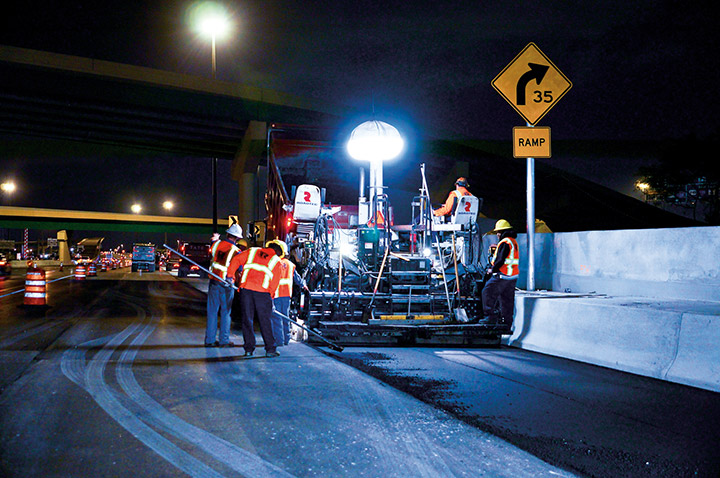Boost the Look of Your Building with Expert Commercial Parking Whole Lot Paving
Boost the Look of Your Building with Expert Commercial Parking Whole Lot Paving
Blog Article
Unlocking the Secrets of Hot Mix Asphalt Innovation
Checking out the depths of hot mix asphalt modern technology uncovers a world where accurate formulations and thorough procedures converge to form our roads and framework. The combination of binders, fillers, and accumulations isn't simply a construction job but a critical orchestration of toughness and efficiency.
Relevance of Hot Mix Asphalt
Warm Mix Asphalt plays a vital role in modern-day infrastructure growth due to its longevity and cost-effectiveness. As the most generally used leading material for roads, freeways, and auto parking lots, Hot Mix Asphalt supplies a variety of advantages that contribute to its value in construction jobs. One vital advantage is its capability to withstand rush hour loads and extreme climate condition, giving a lasting and trustworthy surface area for transportation networks. Furthermore, Warm Mix Asphalt is cost-effective in both preliminary building and construction and long-term maintenance, making it a recommended choice for numerous facilities tasks.
The toughness of Warm Mix Asphalt originates from its make-up, which consists of accumulations, binder, and filler products that are meticulously picked and blended to fulfill certain efficiency demands. This exact combination results in a adaptable and solid sidewalk that can withstand regular use without significant wear and tear. Furthermore, Hot Mix Asphalt is 100% recyclable, more boosting its sustainability and ecological benefits. Overall, the importance of Warm Mix Asphalt in framework growth can not be downplayed, as it remains to be a cornerstone of modern building and construction methods.
Elements of Asphalt Mixes
The structure of asphalt mixes contains meticulously selected accumulations, binder, and filler products that are essential for accomplishing particular efficiency needs. Aggregates are the main element of asphalt mixes, giving toughness and security. These aggregates can be natural, such as gravel or crushed rock, or synthetic, like recycled materials from old sidewalks. The binder, usually bitumen or asphalt concrete, holds the accumulations with each other and gives flexibility and sturdiness to the mix. The option of the binder is essential as it straight influences the mix's performance in different weather problems. Fillers, such as hydrated lime or Portland concrete, are utilized to improve the mix's workability and aging resistance. Angled Parking.
The mix and percentage of these components play a considerable duty in figuring out the top quality and efficiency of the asphalt mix. Engineers very carefully create the mix to satisfy details demands, considering elements like website traffic volume, climate conditions, and sidewalk life-span. Proper choice and harmonizing of aggregates, binder, and fillers are necessary for producing long lasting, long-lasting asphalt pavements.
Combining and Manufacturing Strategies

As soon as the aggregates are chosen, the binder, commonly asphalt cement, is contributed to bind the products together. The binder's high quality and amount significantly influence the mix's toughness, adaptability, and resistance to ecological aspects. Additionally, fillers like moisturized lime or Rose city cement may my website be incorporated to boost particular features of the asphalt mix, such as its workability or moisture resistance.
During manufacturing, the accumulations and binder are warmed, commonly in between 250-325 ° F(121-163 ° C ), to promote mixing and make sure proper finish of the accumulations. The blending process needs to be comprehensive to attain an uniform blend that promotes the desired efficiency qualities of the asphalt. Various techniques, such as batch blending or drum mixing, are used to accomplish high-grade and consistent asphalt mixes for building jobs.
Aspects Impacting Asphalt Efficiency
Factors influencing asphalt performance incorporate a variety of variables that affect the longevity, long life, and overall top quality of asphalt pavements. One key aspect is the quality of products used in the asphalt mix. The kind and resource of aggregates, the binder top quality, and the additives all play a significant hop over to these guys function in determining the efficiency of the asphalt sidewalk. The gradation of accumulations is important as it influences the mix's workability, resistance, and security to splitting and rutting.

Layout considerations, such as sidewalk density and drainage, are vital in making certain the lasting performance of the asphalt pavement. By thoroughly thinking about these aspects, designers and contractors can optimize asphalt performance and enhance the service life of pavements.
Sustainable Practices in Asphalt Technology

WMA permits for the production and positioning of asphalt blends at reduced temperatures contrasted to traditional hot-mix asphalt, resulting in minimized power consumption and greenhouse gas exhausts. The use of permeable asphalt mixes can assist minimize stormwater runoff problems by permitting water to infiltrate via the sidewalk and into the ground, advertising all-natural water filtration and charge procedures.
Conclusion
To conclude, hot mix asphalt innovation plays a critical duty in modern infrastructure advancement because of its longevity and cost-effectiveness. By thoroughly balancing elements, utilizing appropriate blending methods, and taking into consideration numerous variables, designers can develop high-quality asphalt blends that withstand hefty website traffic lots and rough climate problems. Welcoming lasting methods, such as utilizing recycled materials and warm-mix innovations, further boosts the ecological kindness of asphalt innovation.
Mixing and manufacturing strategies in warm mix asphalt innovation involve the precise mix and handling of aggregates, binder, and fillers to create a high-performance and long lasting asphalt mix.Aspects influencing asphalt efficiency include a investigate this site variety of variables that impact the longevity, long life, and general quality of asphalt sidewalks. Sustainable techniques in asphalt technology encompass numerous initiatives aimed at reducing the environmental effect of asphalt manufacturing and paving processes. By incorporating redeemed asphalt pavement (RAP) and recycled asphalt shingles (RAS) into new asphalt blends, the sector can significantly decrease the intake of raw products and energy, while likewise reducing landfill waste.
WMA allows for the production and positioning of asphalt blends at lower temperature levels compared to conventional hot-mix asphalt, resulting in lowered energy consumption and greenhouse gas discharges.
Report this page